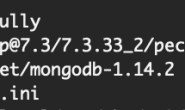源码下载地址是 http://simplehtmldom.sourceforge.net/
相关用法:
How to create HTML DOM object?
Quick way:
$html = str_get_html(‘<html><body>Hello!</body></html>’);
// Create a DOM object from a URL
$html = file_get_html(‘http://www.google.com/’);
// Create a DOM object from a HTML file
$html = file_get_html(‘test.htm’);
Object-oriented way:
$html = new simple_html_dom();
// Load HTML from a string
$html->load(‘<html><body>Hello!</body></html>’);
// Load HTML from a URL
$html->load_file(‘http://www.google.com/’);
// Load HTML from a HTML file
$html->load_file(‘test.htm’);
How to find HTML elements?
Basics:
$ret = $html->find(‘a‘);
// Find (N)th anchor, returns element object or null if not found (zero based)
$ret = $html->find(‘a‘, 0);
// Find all <div> which attribute id=foo
$ret = $html->find(‘div[id=foo]‘);
// Find all <div> with the id attribute
$ret = $html->find(‘div[id]‘);
// Find all element has attribute id
$ret = $html->find(‘[id]‘);
Advanced:
$ret = $html->find(‘#foo‘);
// Find all element which class=foo
$ret = $html->find(‘.foo‘);
// Find all anchors and images
$ret = $html->find(‘a, img‘);
// Find all anchors and images with the “title” attribute
$ret = $html->find(‘a[title], img[title]‘);
Descendant selectors:
$es = $html->find(‘ul li‘);
// Find Nested <div> tags
$es = $html->find(‘div div div‘);
// Find all <td> in <table> which class=hello
$es = $html->find(‘table.hello td‘);
// Find all td tags with attribite align=center in table tags
$es = $html->find(”table td[align=center]‘);
Nested selectors:
foreach($html->find(‘ul‘) as $ul)
{
foreach($ul->find(‘li‘) as $li)
{
// do something…
}
}
// Find first <li> in first <ul>
$e = $html->find(‘ul‘, 0)->find(‘li‘, 0);
Attribute Filters:
| Filter | Description |
|---|---|
| [attribute] | Matches elements that have the specified attribute. |
| [attribute=value] | Matches elements that have the specified attribute with a certain value. |
| [attribute!=value] | Matches elements that don’t have the specified attribute with a certain value. |
| [attribute^=value] | Matches elements that have the specified attribute and itstarts with a certain value. |
| [attribute$=value] | Matches elements that have the specified attribute and itends with a certain value. |
| [attribute*=value] | Matches elements that have the specified attribute and itcontains a certain value. |
Text & Comments:
$es = $html->find(‘text‘);
// Find all comment (<!–…–>) blocks
$es = $html->find(‘comment‘);
How to access the HTML element’s attributes?
Get, Set and Remove attributes:
$value = $e->href;
// Set a attribute(If the attribute is non-value attribute (eg. checked, selected…), set it’s value as true or false)
$e->href = ‘my link’;
// Remove a attribute, set it’s value as null!
$e->href = null;
// Determine whether a attribute exist?
if(isset($e->href))
echo ‘href exist!’;
Magic attributes:
$html = str_get_html(“<div>foo <b>bar</b></div>”);
$e = $html->find(“div”, 0);
echo $e->tag; // Returns: ” div”
echo $e->outertext; // Returns: ” <div>foo <b>bar</b></div>”
echo $e->innertext; // Returns: ” foo <b>bar</b>”
echo $e->plaintext; // Returns: ” foo bar”
| Attribute Name | Usage |
|---|---|
| $e->tag | Read or write the tag name of element. |
| $e->outertext | Read or write the outer HTML text of element. |
| $e->innertext | Read or write the inner HTML text of element. |
| $e->plaintext | Read or write the plain text of element. |
Tips:
echo $html->plaintext;
// Wrap a element
$e->outertext = ‘<div class=”wrap”>’ . $e->outertext . ‘<div>’;
// Remove a element, set it’s outertext as an empty string
$e->outertext = ”;
// Append a element
$e->outertext = $e->outertext . ‘<div>foo<div>’;
// Insert a element
$e->outertext = ‘<div>foo<div>’ . $e->outertext;
How to traverse the DOM tree?
Background Konwledge:
// Example
echo $html->find(“#div1”, 0)->children(1)->children(1)->children(2)->id;
// or
echo $html->getElementById(“div1”)->childNodes(1)->childNodes(1)->childNodes(2)->getAttribute(‘id’);
Traverse the DOM tree:
| Method | Description |
|---|---|
|
mixed
$e->children ( [int $index] ) |
Returns the Nth child object if index is set, otherwise return anarray of children. |
|
element
$e->parent () |
Returns the parent of element. |
|
element
$e->first_child () |
Returns the first child of element, or null if not found. |
|
element
$e->last_child () |
Returns the last child of element, or null if not found. |
|
element
$e->next_sibling () |
Returns the next sibling of element, or null if not found. |
|
element
$e->prev_sibling () |
Returns the previous sibling of element, or null if not found. |
How to dump contents of DOM object?
Quick way:
$str = $html;
// Print it!
echo $html;
Object-oriented way:
$str = $html->save();
// Dumps the internal DOM tree back into a file
$html->save(‘result.htm’);
How to customize the parsing behavior?
function my_callback($element) {
// Hide all <b> tags
if ($element->tag==’b’)
$element->outertext = ”;
}
// Register the callback function with it’s function name
$html->set_callback(‘my_callback’);
// Callback function will be invoked while dumping
echo $html;
——————————————————更多资料请参看官方网站——————————————————

 微信扫一扫,打赏作者吧~
微信扫一扫,打赏作者吧~

